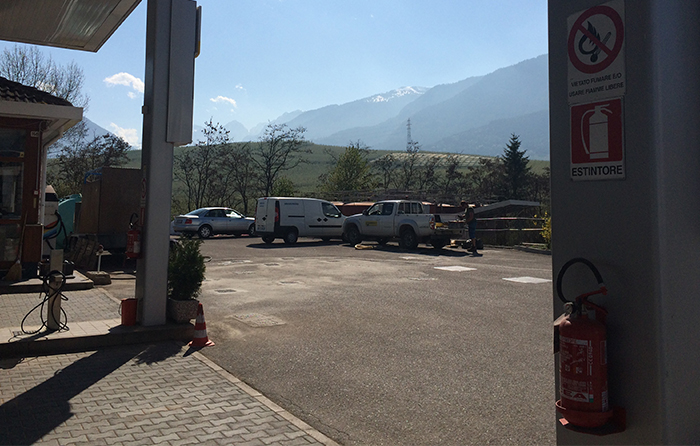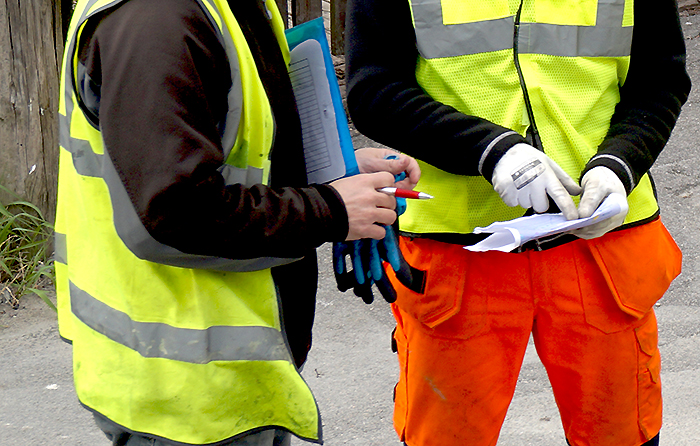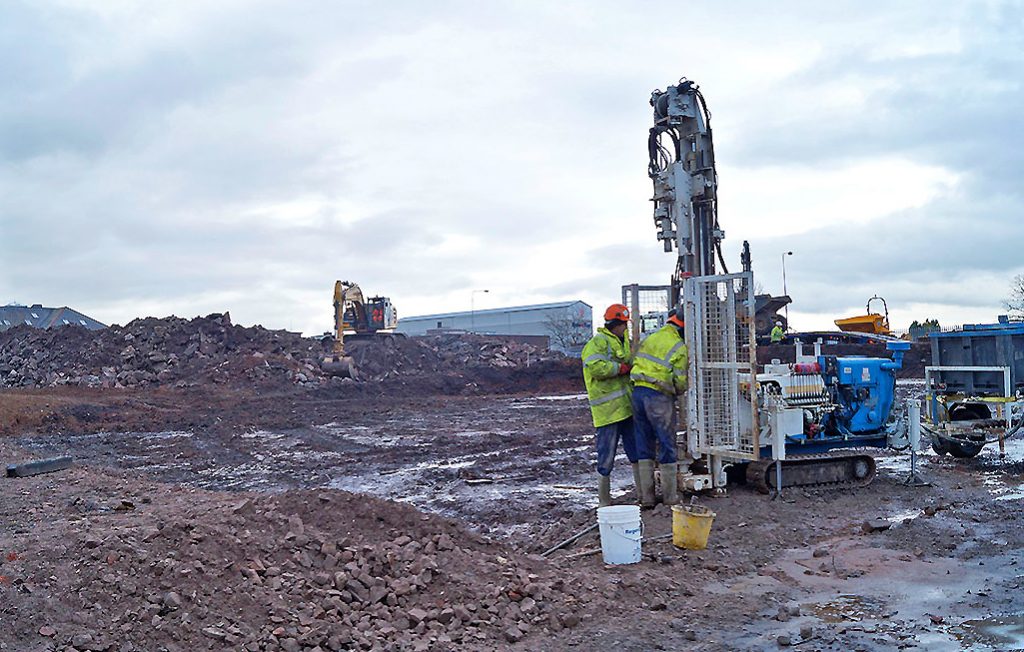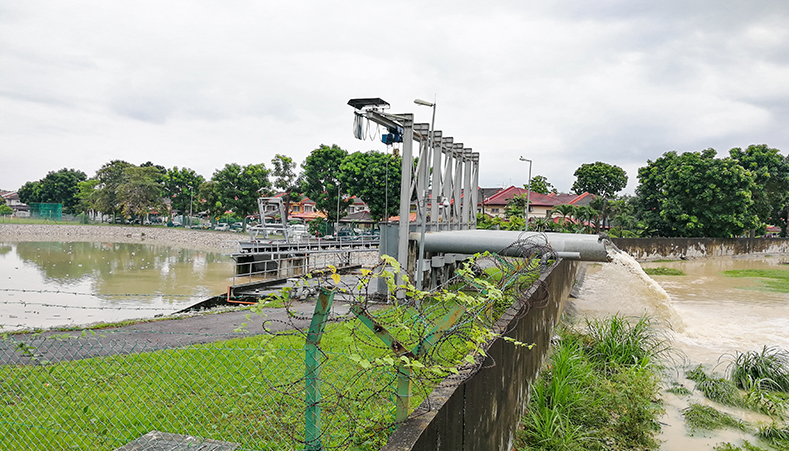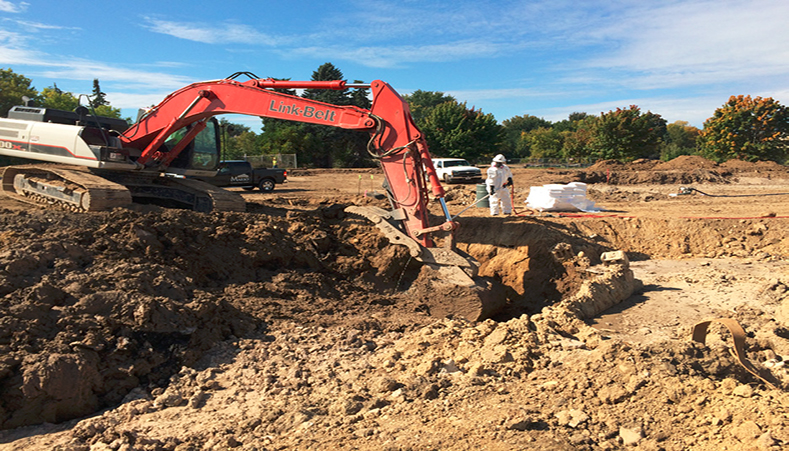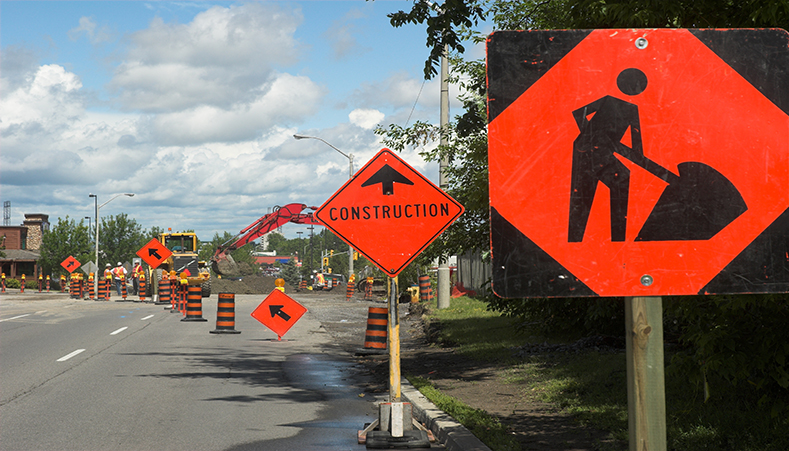Remediation at Active Petrol Filling Station in North Italy
Integrated treatment of petroleum hydrocarbons via enhanced physical extraction and aerobic bioremediation with PetroCleanze and ORC AdvancedRead More
In Situ Remediation of Petroleum Hydrocarbons in Deep Chalk
From LNAPL to less than 1,000 μg/L in seven months using an integrated treatment approach Read More
Petroleum Contaminated Groundwater Treatment, West London, UK
Installation of ORC-Advanced barrier successfully reduced the contaminant influx onto the site, allowing for site redevelopment without any disruption Read More
Hotspot Treatment of Petroleum Hydrocarbons – North West, UK
Phased, in situ treatment with PetroCleanze and ORC-A Socks allows main contractor to keep programme on trackRead More
Enhanced Recovery & Biodegradation of Petroleum Hydrocarbons – Sweden
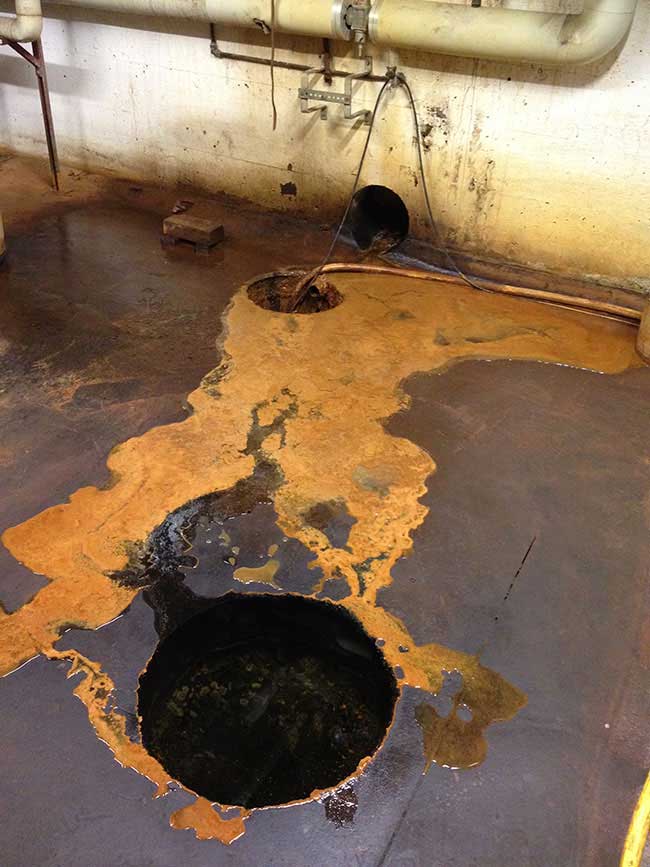
Summary
A site investigation undertaken by a remediation contractor in Växjö, Sweden, identified up to 1.4 m of LNAPL on top of the groundwater beneath an industrial unit. The source of the contamination was a boiler in the basement of the facility. It was determined that the contamination posed a vapour risk to the site users. The proposed strategy was therefore to remove the LNAPL, reduce the adsorbed mass and treat the dissolved phase contamination to low levels. This was to be completed within the building, it’s basement and the car park downgradient.

Treatment
In order to efficiently address both the free and dissolved phase petroleum hydrocarbon contamination an integrated in-situ remediation strategy was adopted. A Multi-Phase Extraction (MPE) system was installed across the target area. This was used firstly to extract the easily removable LNAPL observed at the site. Following this, several round of PetroCleanze® were applied into the subsurface to cause the temporary desorption of the soil contamination within the smear zone. The MPE system was then used to remove this ‘rebound’ each time.
Once no further LNAPL was observed after the PetroCleanze application, ORC Advanced® was applied to enhance the biological degradation of the residual dissolved phase contamination to reach the target values.
What’s Special
- An integrated in situ remediation method allowed for treatment of LNAPL down to low dissolved phase contamination under an industrial unit, avoiding any demolition or excavation.
- PetroCleanze enhanced the performance of the MPE in order to reduce the asymptote achieved and avoid rebound from residual sorbed contamination.
- Augmentation of the MPE reduced time onsite and the cost of the remediation programme.
- ORC Advanced was used once only dissolved phase contamination was observed, maintaining the efficiency of the remedial programme and successfully achieving stringent target values.
PlumeStop and ORC Advanced Treat BTEX to Non-Detect in 1 Month
Project Highlights
- Benzene (BTEX) and TPH-d (diesel) were reduced to non-detect within one month with no rebound
- Pre-project verification testing provided hydrogeological data to optimize the successful application of PlumeStop and ORC Advanced
- Active site did not impede remediation efforts
1m 53s reading time
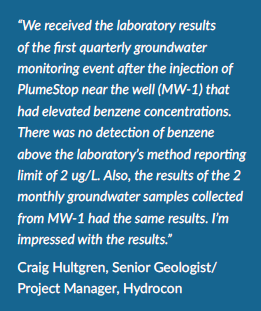
Project Summary
An active gas station in the Pacific Northwest was impacted with BTEX concentrations from a petroleum release. Following remediation of the source, residual BTEX concentrations persisted in a down gradient well. A new combined remedies in situ program using PlumeStop and ORC Advanced was designed. Following the verification testing, REGENESIS co-applied PlumeStop and ORC Advanced into the residual BTEX plume. After one month, sampling was conducted showing contaminants had been dramatically reduced to non-detect levels.
Remediation Approach
REGENESIS worked closely with the project consultant to complete a multi-step verification process prior to remediation. This procedure included a clear water injection to test aquifer properties and soil borings for detailed characterization of the proposed treatment area. This was followed by a pilot injection of PlumeStop to test distribution. The verification testing found that despite soils at the site being classified as clays and silts, there was a sufficient amount of sand present to allow for good distribution. Injection pressures remained below 5 psi for PlumeStop and below 10 psi for ORC Advanced. Distribution of greater than 12 feet was also observed. The verification process was an integral part of the project, helping to more accurately characterize true hydrogeologic conditions. Technical Engineers were able to take the information obtained from the verification process and optimize the PlumeStop and ORC Advanced design. The co-application of the two technologies quickly sorbed dissolved-phase contaminants and promoted aerobic biodegradation.
REGENESIS Solution Applied
PlumeStop Liquid Activated Carbon™ is composed of very fine particles of activated carbon (1-2μm) suspended in water through the use of unique organic polymer dispersion chemistry. Once in the subsurface, the material behaves as a colloidal biomatrix binding to the aquifer matrix, rapidly removing contaminants from groundwater, and expediting permanent contaminant biodegradation. ORC Advanced is a proprietary formulation of food-grade, calcium oxy-hydroxide that produces a controlled release of molecular oxygen for periods of up to 12 months upon hydration.
Results
Residual BTEX and TPH-d concentrations lingering for years are common for gas station sites and often are the only obstacle to closure. The combined remedies application of PlumeStop and ORC Advanced demonstrates a unique ability to attain non-detect levels in a short time frame with substantial cost savings over other approaches, including natural attenuation.
High TPH Concentrations Treated Using PersulfOx® and ORC® Advanced
Future Site of Stormwater Retention Ponds Remediated with ISCO, Enhanced Aerobic Biodegradation
Project Highlights
- Initial treatment with aerobic bioremediation effectively removed 60% of site contamination.
- PersulfOx® and ORC® Advanced were used to treat two remaining hot spot areas.
- Site closure is pending additional groundwater monitoring.
- Contamination concentrations must be reduced to meet stringent groundwater quality standards.
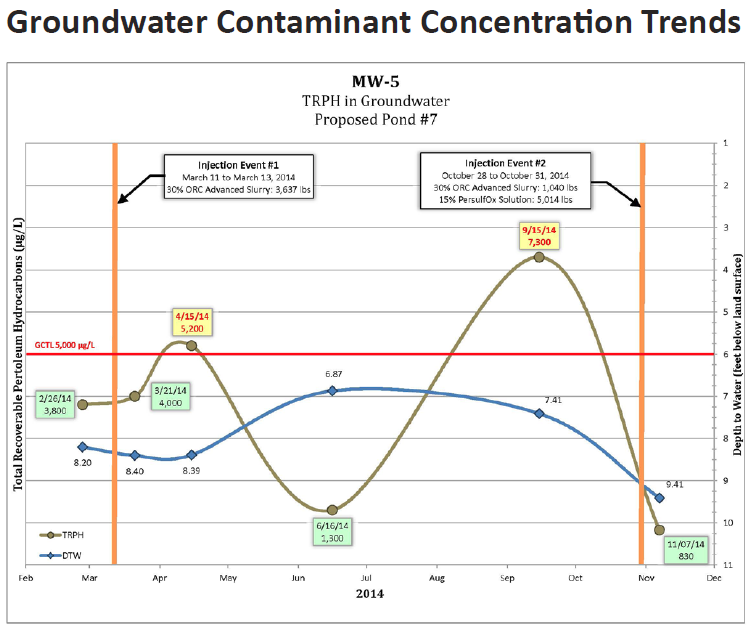
Project Summary
This site is a former commercial facility in the Southeast with high TRPH contaminant impacts to soils and groundwater. The property is currently vacant and the state department of transportation plans to create a stormwater retention pond on site. However, contaminant concentrations in groundwater need to be reduced to meet stringent groundwater quality standards before any construction can begin.
The plume was first treated via enhanced aerobic bioremediation with ORC Advanced, which effectively removed over 60% of the dissolved-phase contamination within 18 months. In two hot spot areas, residual contamination in the smear zone continued to cause impacts to groundwater. A follow-up treatment combining in situ chemical oxidation and enhacned aerobic bioremediation was employed. PersulfOx and ORC Advanced were used to bring this site towards closure by effectively treating these two hot spot areas. Initial sampling results 30 days after treatment showed attainment of groundwater quality standards.
Remediation Approach
ORC Advanced was injected over 60 direct-push locations across two plume areas. A year and a half post-application, two remaining hot spot areas with residual capillary fringe contamination had caused continued issues. PersulfOx and ORC Advanced were used to bring this site towards closure by effectively treating these two hot spot areas.
Technology Description
ORC Advanced is a proprietary formulation of food-grade, calcium oxy-hydroxide that produces a controlled-release of molecular oxygen for periods of up to 12 months upon hydration.
PersulfOx is a sodium persulfate-based chemical oxidation technology which destroys both hydrocarbon and chlorinated solvent-type contaminants in the subsurface. PersulfOx contains a built-in catalyst which activates the persulfate component and generates contaminant-destroying free radicals without the need for the addition of a separate activator.
Acetone and Petroleum Hydrocarbons Treated at Active Industrial Facility
Combined ISCO/Bioremediation Treatment Approach Reduces Contamination Levels
Project Highlights
- Acetone concentrations pre-remedation were as high as 54,000 μg/L
- Site access agreement required that existing site operations could not be interrupted for construction
- Site water was not allowed to be used therefore all water had to be trucked in and a separate water permit to access city water from fire hydrants was required
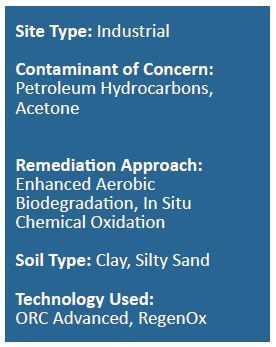
Project Summary
A former industrial facility in northern California operated as a gas manufacturing plant from the early 1900s until it was decommissioned in 2001 and sold. The property is currently leased by a bottled water distribution facility.
At this facility, acetone was used extensively in acetylene manufacturing. The acetone was stored on-site in underground storage tanks (UST) but no evidence of leaking acetone USTs was found.
However, high concentrations of acetone – a pre-remediation maximum of 54,000 micrograms per liter (μg/L) were found in one area of the site. Other dissolved chemicals of concern (COC) include gasoline and gasoline-range petroleum hydrocarbons from former USTs such as benzene, toluene, ethylbenzene and xylenes (BTEX).
The extent of contamination in the early 1990s extended to large portions of the site. A pump and treat system was used on-site in 2005, however contamination persisted. Contamination approximately 12 feet below ground surface was detected within the soil. A remediation plan using both ORC® Advanced and RegenOx® was used to treat the remaining contamination.
The site access agreement for this project required that existing site operations could not be interrupted for construction. In order to minimize disturbance to tenants and work within these constraints, all drilling field work was performed on weekends. Site water was not allowed to be used therefore all water had to be trucked in and a separate water permit to access city water from fire hydrants was required. In addition, multiple drill rigs and support vehicles operated within a small area, increasing logistical and safety concerns.
Remediation Approach
A mixture of 6,500 pounds of RegenOx and 3,000 pounds of ORC Advanced was injected at 45 locations using multiple direct-push drill rigs. The injection points were designed in a grid pattern with a nominal 15-foot spacing between injection points, but more densely placed in the area of highest contaminant concentration. Benzene concentrations in groundwater have stabilized at about 10 μg/L and acetone concentrations have stabilized at about 1,600 μg/L. Post-treatment monitoring results show that all the COCs in the treatment area have consistently remained below health-based cleanup levels since the treatment was applied.
Technology Description
Advanced Formula Oxygen Release Compound (ORC Advanced®) is a proprietary formulation of food-grade, calcium oxy-hydroxide that produces a controlled-release of molecular oxygen for periods of up to 12 months upon hydration.
RegenOx is an advanced chemical oxidation technology that destroys contaminants through powerful, yet controlled chemical reactions and not through biological means. This product maximizes in situ performance while using a solid alkaline oxidant that employs a sodium percarbonate complex with a multi-part catalytic formula.
Open Excavation Treatment at Former NJ Service Station
RegenOx® and ORC® Advanced Pellets Remediate Petroleum Hydrocarbon Contamination
Project Highlights
- Former service station contaminated with BTEX levels measuring 11 ppm in groundwater and soil impacts removed through excavation
- Combined remedy to treat the open excavation with both in situ chemical oxidation and enhanced aerobic bioremediation technologies
- RegenOx and ORC Advanced Pellets technologies are compatible/non-corrosive with underground infrastructure and utilities infrastructure in the subsurface

Project Summary
A former service station in New Jersey was contaminated with high levels of BTEX (measuring 11 ppm in groundwater pre-treatment). Due to significant amounts of contaminated soil mass remaining at the former service station, an excavation was proposed by the environmental consultant. RegenOx and ORC Advanced Pellets were applied to the open excavation to chemically oxidize remaining saturated impacts and to promote enhanced aerobic biodegradation of petroleum hydrocarbons in the dissolved phase. Both of these technologies utilize alkaline chemistry (pH > 8), which is non-corrosive to nearby public utilities and the underground infrastructure at the service station.
Remediation Approach
RegenOx and ORC Advanced were co-applied into an open excavation at the former service station site. The excavation extended approximately four feet into the saturated zone. Because the excavation was limited by physical constraints, RegenOx, a chemical oxidant, was applied to the base of the excavation to oxidize and desorb residual petroleum mass from the soil. ORC Advanced Pellets were co-applied to provide a slow release of oxygen (up to 12 months longevity) that promotes enhanced aerobic biodegradation of petroleum hydrocarbons. In total, 2,000 pounds of RegenOx and 882 pounds of ORC Advanced Pellets were co-applied to the 2,600 square foot excavation area.
Technology Description
The advanced formulation of the Oxygen Release Compound (ORC Advanced) is a proprietary formulation of food-grade, calcium oxy-hydroxide that produces a controlled-release of molecular oxygen for periods of up to 12 months upon hydration. The pelletized form of ORC Advanced were designed to improve safety and handling for excavation applications.
RegenOx is an advanced chemical oxidation technology that destroys contaminants through powerful, yet controlled direct oxidation and free-radical reactions. This product maximizes in situ performance through the use of a solid alkaline oxidant (a sodium percarbonate complex) and a multi-part catalyst. These oxidation reactions do not inhibit natural bacterial populations and are compatible with biological treatment methods.
Combined Remedies Treat BTEX Contamination on Government Property
Ontario, Canada Site Remediated with ORC® Advanced and RegenOx®
Project Highlights
- In Situ Chemical Oxidation (ISCO) and Enhanced Biodegradation used post-excavation to treat residual contamination.
- Extensive site mapping conducted with membrane interface probe (MIP) to detect distinct zones of higher mass contamination.
- 95% reductions seen in dissolved phase petroleum hydrocarbon contamination.
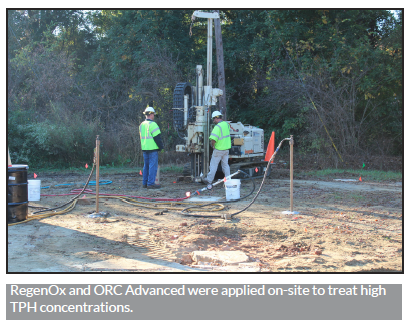
Project Summary
A large public works property in Ontario, Canada was contaminated with TPH. Approximately 5,000 gallons of fuel was released into the subsurface primarily due to fuel theft that had taken place on-site. Due to significant volumes of free-product, an excavation occurred followed by skimming activities from 2005-2010. Through extensive site evaluation, it was determined that there was a need for further mass reduction using ISCO.. RegenOx® ISCO was selected for use in the heavily and moderately impacted areas. Enhanced aerobic biodegradation using ORC® Advanced was selected for use in the dissolved-phase areas downgradient from the source. Overall, 96% reductions were seen in dissolved phase petroleum hydrocarbon concentrations.
Remediation Approach
Membrane interface probe (MIP) data was collected and proved to be integral for the remediation design and implementation. Distinct zones with high mass were present on-site and detected through the probe. RegenOx and ORC Advanced were applied via direct-push injections. Approximately 150,000 pounds of RegenOx and 45,000 pounds of ORC Advanced were applied over several injections. Higher concentrations of RegenOx were applied into the vertical zones of higher contamination to improve overall product performance.
Technology Description
Advanced Formula Oxygen Release Compound is a proprietary formulation of food-grade, calcium oxy-hydroxide that produces a controlled-release of molecular oxygen for periods of up to 12 months upon hydration.
RegenOx is an advanced chemical oxidation technology that destroys contaminants through powerful, yet controlled chemical reactions and not through biological means. This product maximizes in situ performance while using a solid alkaline oxidant that employs a sodium percarbonate complex with a multi-part catalytic formula.

 Americas
Americas Europe
Europe Français
Français Deutsch
Deutsch Italiano
Italiano Español
Español